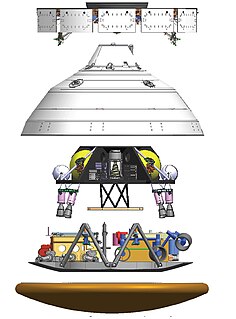 Artist's illustration of ExoMars 2016 | |||||||||||
| Mission type | Mars orbiter | ||||||||||
|---|---|---|---|---|---|---|---|---|---|---|---|
| Operator | ESA · Roscosmos | ||||||||||
| COSPAR ID | 2016-017A | ||||||||||
| SATCAT no. | 41388 | ||||||||||
| Website | http://exploration.esa.int/jump.cfm?oid=46475 | ||||||||||
| Mission duration | Planned: 7 years [1] [2] Elapsed: 3 years, 1 month, 1 day | ||||||||||
| Spacecraft properties | |||||||||||
| Manufacturer | Thales Alenia Space | ||||||||||
| Launch mass | 3,755 kg (8,278 lb) [3] | ||||||||||
| Payload mass | Instruments: 113.8 kg (251 lb) [3] Schiaparelli: 577 kg (1,272 lb) [3] | ||||||||||
| Dimensions | 3.2 × 2 × 2 m (10.5 × 6.6 × 6.6 ft) [3] | ||||||||||
| Power | ~2000 W [3] | ||||||||||
| Start of mission | |||||||||||
| Launch date | 14 March 2016, 09:31 UTC [4] | ||||||||||
| Rocket | Proton-M/Briz-M | ||||||||||
| Launch site | Baikonur 200/39 | ||||||||||
| Contractor | Khrunichev | ||||||||||
| Orbital parameters | |||||||||||
| Reference system | Areocentric | ||||||||||
| Regime | Circular | ||||||||||
| Eccentricity | 0 | ||||||||||
| Periareion | 400 km (250 mi) | ||||||||||
| Apoareion | 400 km (250 mi) | ||||||||||
| Inclination | 74 degrees | ||||||||||
| Period | 2 hours | ||||||||||
| Epoch | Planned | ||||||||||
| Mars orbiter | |||||||||||
| Orbital insertion | 19 October 2016, 15:24 UTC [5] | ||||||||||
| Transponders | |||||||||||
| Band | X band UHF band | ||||||||||
| Frequency | 390–450 MHz | ||||||||||
| TWTA power | 65 W | ||||||||||
| |||||||||||
 ESA mission insignia for the ExoMars 2016 launch, featuring the Trace Gas Orbiter (left) and Schiaparelli (right). ExoMars programme | |||||||||||
The ExoMars Trace Gas Orbiter (TGO or ExoMars Orbiter) is a collaborative project between the European Space Agency (ESA) and Roscosmos that sent an atmospheric research orbiter and the Schiaparelli demonstration lander to Mars in 2016 as part of the European-led ExoMars programme. [6] [7] [8]

The European Space Agency is an intergovernmental organisation of 22 member states dedicated to the exploration of space. Established in 1975 and headquartered in Paris, France, ESA has a worldwide staff of about 2,200 in 2018 and an annual budget of about €5.72 billion in 2019.

The Roscosmos State Corporation for Space Activities, commonly known as Roscosmos, is a state corporation responsible for the wide range and types of space flights and cosmonautics programs for the Russian Federation.
An orbiter is a space probe that orbits a planet or other astronomical object.
Contents
- History
- Origins
- Attempted collaboration with NASA
- Collaboration with Russia
- Launch
- Status
- Specifications
- Science
- Payload
- Relay telecommunications
- Results
- See also
- References
- External links
The Trace Gas Orbiter delivered the Schiaparelli lander on 16 October 2016, which crashed on the surface. [9]
The orbiter began aerobraking in March 2017 to lower its initial orbit of 200 by 98,000 km (120 by 60,890 mi). Aerobraking concluded on 20 February 2018 when a final thruster firing resulted in an orbit of 200 by 1,050 km (120 by 650 mi). [10] Additional thruster firings every few days raised the orbiter to a circular "science" orbit of 400 km (250 mi), which was achieved on 9 April 2018. [11]

Aerobraking is a spaceflight maneuver that reduces the high point of an elliptical orbit (apoapsis) by flying the vehicle through the atmosphere at the low point of the orbit (periapsis). The resulting drag slows the spacecraft. Aerobraking is used when a spacecraft requires a low orbit after arriving at a body with an atmosphere, and it requires less fuel than does the direct use of a rocket engine.
A key goal is to gain a better understanding of methane (CH
4) and other trace gases present in the Martian atmosphere that could be evidence for possible biological activity. The programme will follow with the Surface Science Platform and the Rosalind Franklin rover in 2020, [12] which will search for biomolecules and biosignatures; the TGO will operate as the communication link for the ExoMars lander and rover and provide communication for other Mars surface probes with Earth.
The ExoMars Kazachok is a planned robotic Mars lander led by the Roscosmos, part of the ExoMars 2020 mission by the Roscosmos and the European Space Agency.

Rosalind Franklin, previously known as the ExoMars rover, is a planned robotic Mars rover, part of the international ExoMars programme led by the European Space Agency and the Russian Roscosmos State Corporation.

A biomolecule or biological molecule is a loosely used term for molecules and ions that are present in organisms, essential to some typically biological process such as cell division, morphogenesis, or development. Biomolecules include large macromolecules such as proteins, carbohydrates, lipids, and nucleic acids, as well as small molecules such as primary metabolites, secondary metabolites, and natural products. A more general name for this class of material is biological materials. Biomolecules are usually endogenous but may also be exogenous. For example, pharmaceutical drugs may be natural products or semisynthetic (biopharmaceuticals) or they may be totally synthetic.




























